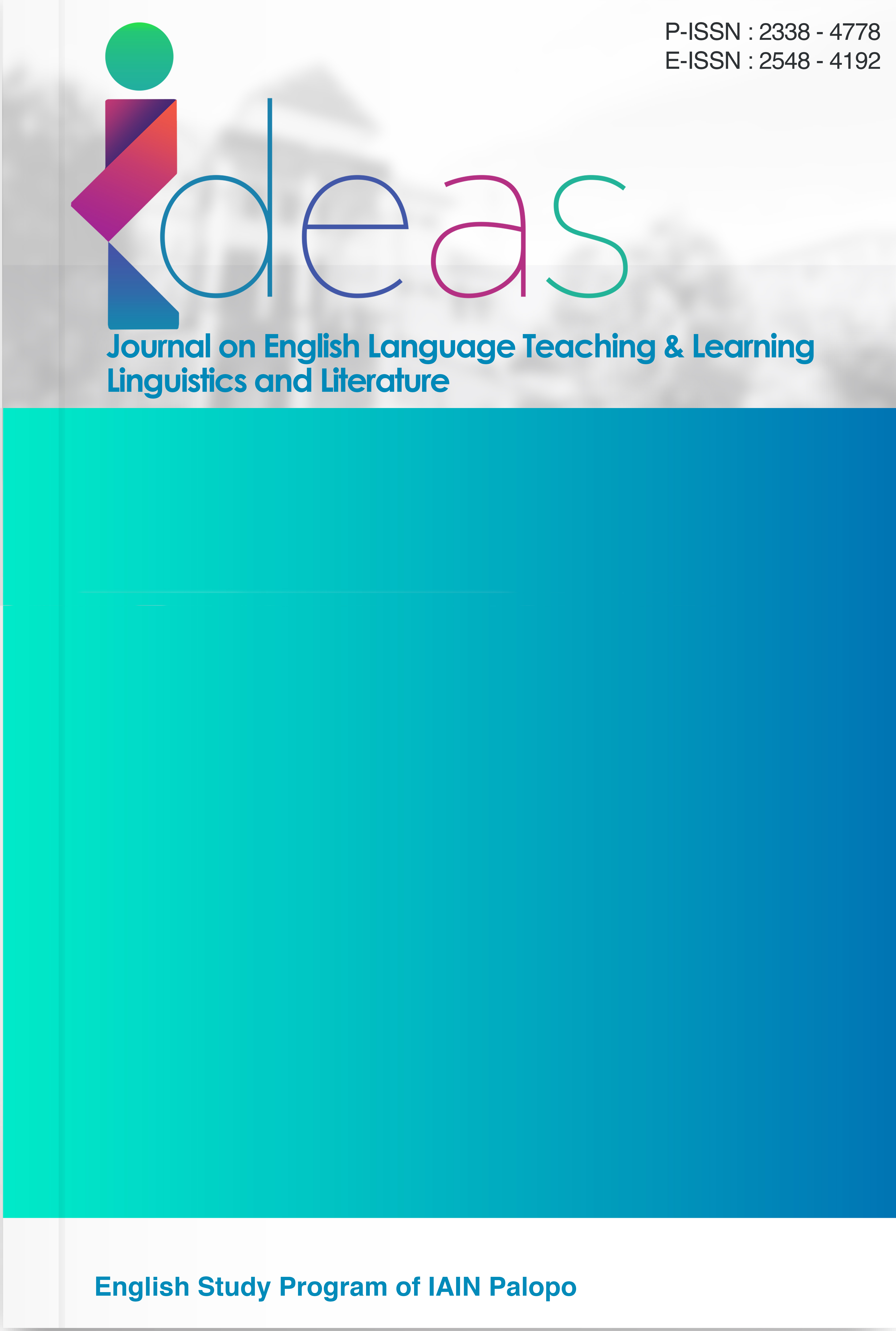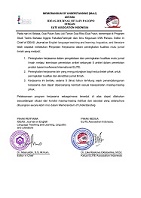Enhancing Writing Skill with Gamified Learning: Developing Sentence and Vocabulary for Fifth Grade Students at Sri Aman Suksa School
DOI:
https://doi.org/10.24256/ideas.v13i2.7925Keywords:
Gamified Learning, Writing Skills, Sentence and Vocabulary.Abstract
This study is aimed at examining the effectiveness of gamified learning for enhancing English writing skills, particularly focusing on sentence construction and vocabulary enrichment, towards the fifth-grade students at Sri Aman Suksa School, Thailand. The research utilized a quantitative methodology incorporating pre-test and post-test frameworks. There were 25 students engaged in the research, undertaking a writing pre-test prior to the treatment and a post-test subsequent to the implementation of gamified learning activities. To address the abnormal distribution in the post-test data, the Wilcoxon Signed Rank Test was utilised to assess the significant difference between pre-test and post-test outcomes. The results indicated that students' preliminary writing proficiency was average, characterized by recurrent grammatical inaccuracies and restricted vocabulary utilization. Following the implementation of gamified learning activities, their post-test performance improved by 19 points on average (from 53.44 to 72.44), a statistically significant enhancement (p = 0.000). The effect size analysis revealed a Cohen’s d value of 1.15, indicating a substantial and significant effect. The findings indicate that gamified learning fostered engaging and motivating learning, allowing students to formulate more precise sentences and effectively broaden their vocabulary. In conclusion, gamified learning is an effective educational approach for enhancing writing skills in primary-level English as a Foreign Language (EFL) setting. It underscores the potential of a gamified learning approach to improve students’ writing skills. Furthermore, it provides significant implications for English language instruction at the primary education level.
References
Cahyani, I., Nurhadi, J., & Mentari. (2023). Enhancing writing skills and language creativity through the plus-minus-interesting technique: A case study at the primary school level. Indonesian Journal of Applied Linguistics, 13(1), 63–71. https://doi.org/10.17509/ijal.v13i1.58257
Creswell. (2012). Educational Research: Planning, Conducting, and Evaluating Quantitative and Qualitative Research (7th ed.). Pearson.
Creswell. (2014). Educational Research: Planning, Conducting, and Evaluating Quantitative and Qualitative Research (4th ed.). Pearson.
Etikan, I. (2016). Comparison of Convenience Sampling and Purposive Sampling. American Journal of Theoretical and Applied Statistics, 5(1), 1. https://doi.org/10.11648/j.ajtas.20160501.11
Farhady, H. (2013). Quantitative Methods. The Encyclopedia of Applied Linguistics. https://doi.org/DOI: 10.1002/9781405198431
Fathimatuzahro, M., & Rizkiyah, F. (2025). AI-driven feedback in EFL students’ writing: Does it enhance their skills? Celtic : A Journal of Culture, English Language Teaching, Literature and Linguistics, 12(1), 637–657. https://doi.org/10.22219/celtic.v12i1.40594
Field, A. (2017). Discovering Statistics Using IBM SPSS Statistics (5th ed.). Sage Publication, 53(9), 1689–1699.
Guzel, S., & Yilmez, C. (2024). The Effect of Gamified and Blended Modules on English as a Foreign Language Learners’ Language Skills. Necatibey Eğitim Fakültesi Elektronik Fen ve Matematik Eğitimi Dergisi, 17(2), 809–830. https://doi.org/10.17522/balikesirnef.1383324
Jayanti, W. M. M., Firdaus, M. Y., & Arochman, T. (2024). The effectiveness of integrating Classcraft, a gamified learning platform, on enhancing writing skills among elementary school learners. English Learning Innovation, 5(2), 277–286.
Jumariati, Nasrullah, Sutiono, C., & Utomo, M. K. (2024). A Study on EFL Students’ Level of Critical Thinking Skills. Celtic : A Journal of Culture, English Language Teaching, Literature and Linguistics, 11(2), 215–231. https://doi.org/10.22219/celtic.v11i2.
Mardiah, H. (2020). the Value of Teachers’ Effective Praise and Feedback to Adult Learners to Create a Positive Classroom Climate. Vision, 16(1). https://doi.org/10.30829/vis.v16i1.714
McNamara, D. S., Crossley, S. A., & McCarthy, P. M. (2024). Linguistic Features of Writing Quality: Complexity and Diversity in Syntactic and Lexical Choices. Languuage Learning and Development, 20(1), 12–35. https://doi.org/https://doi.org/10.1177/0741088309351547
Mohamad, M., Ibrahim, N. A. E., Nasaruddin, N., & Zakaria, N. Y. K. (2024). The Impact of Gamified Learning Techniques in Improving Writing Skills Outcomes: A Systematic Review. International Journal of Academic Research in Business and Social Sciences, 14(8), 2506–2519. https://doi.org/10.6007/ijarbss/v14-i8/22623
Nissa, K., Mawaddah, S., & Wahyuni, R. (2024). The Benefits of Journal Writing in EFL Classrooms. Teaching English Linguistics Literature Usage, 10(1), 249–267. https://doi.org/10.22202/tus.2024.v10i1.7952
Osadhi, S. Y. (2024). The Effect of Vocabulary Learning Gamification on Students’ Vocabulary Development (pp. 21–29).
Pallant, J. (2020). SPSS Survival Manual A step-by-step guide to data analysis using IBM SPSS (7th ed.). Routledge. https://doi.org/https://doi.org/10.4324/9781003117452
Pingmuang, P., & Koraneekij, P. (2022). Mobile-Assisted Language Learning Using a Task-Based Approach and Gamification for Enhancing Writing Skills in EFL Students. Electronic Journal of E-Learning, 20(5), 623–638. https://doi.org/10.34190/ejel.20.5.2339
Sagala, R. W., & Syahputra, B. P. (2022). GAMIFICATION ACTIVITIES ENGAGING PROSPECTIVE ELEMENTARY TEACHERS DURING ONLINE LEARNING Pendidikan Bahasa Inggris , Fakultas Keguruan dan Ilmu Pendidikan , Universitas Muhammadiyah Sumatera Utara, Indonesia Coresponding email : rakhmatwahyudin@umsu.ac.id. 5(2).
Sahnan, B., & Daulay, S. H. (2025). Developing Students’ Vocabulary by Using Build-A-Sentence: Teachers’ Perspective. Scope : Journal of English Language Teaching, 9(2), 692. https://doi.org/10.30998/scope.v9i2.22547
Satriani, S., Syamsuddin, A., & Tamanga, N. (2024). Identification of Student Learning Styles in Implementing Differentiation Learning in Thai Islamic Schools. European Journal of Education and Pedagogy, 5(1), 31–34. https://doi.org/10.24018/ejedu.2024.5.1.750
Skar, G. B., Graham, S., Huebner, A., Kvistad, A. H., Johansen, M. B., & Aasen, A. J. (2024). A longitudinal intervention study of the effects of increasing the amount of meaningful writing across grades 1 and 2. Reading and Writing, 37(6), 1345–1373. https://doi.org/10.1007/s11145-023-10460-0
Suryani, K. G., & Permana, I. G. Y. (2024). The Effect of Gamification on Four-Grade Students ’ Writing Competency. 1(1), 41–45.
Wang, W., & Zhou, C. (2017). Effective Strategies to Improve English Teaching. January 2007, 217–220. https://doi.org/10.5220/0006447502170220
Xu, J., & Li, C. (2021). The effects of the timing of form-focused instruction on EFL learners’ learning of difficult and easy grammatical features: A comparative study. System, 101 (September 2020), 102612. https://doi.org/10.1016/j.system.2021.102612
Downloads
Published
Issue
Section
Citation Check
License
Copyright (c) 2025 Keyti Endhita, Henny Mardiah

This work is licensed under a Creative Commons Attribution-ShareAlike 4.0 International License.
Authors retain copyright and grant the journal right of first publication with the work simultaneously licensed under an Attribution-ShareAlike 4.0 International (CC BY-SA 4.0) that allows others to share the work with an acknowledgement of the work's authorship and initial publication in this journal.
Authors are able to enter into separate, additional contractual arrangements for the non-exclusive distribution of the journal's published version of the work (e.g., post it to an institutional repository or publish it in a book), with an acknowledgement of its initial publication in this journal.
Authors are permitted and encouraged to post their work online (e.g., in institutional repositories or on their website) prior to and during the submission process, as it can lead to productive exchanges, as well as earlier and greater citation of published work (See the Effect of Open Access)




